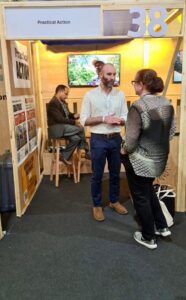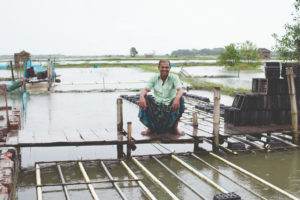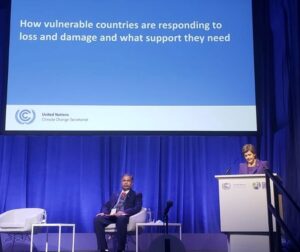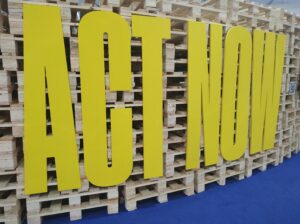Taking practical action at COP28
As the climate crisis disproportionately impacts low-income countries and communities, Practical Action will once again be attending the United Nations Climate Change Conference of Parties (COP) at COP28 in Dubai.
We will be there to hold the process to account and ensure that the voices of the people we work with are heard as global leaders take decisions about all our futures.
This is our 8th consecutive year at the COP negotiations, so we know it’s an ambitious task and I have seen for myself that this comes with several challenges.

Oliver Arnold-Richards was at the COP 27 talks last year.
The current state-of-play
One of the main highlights of COP27 was the agreement to establish a Loss and Damage Fund, which will provide finance to nations experiencing devastating climate impacts but who have contributed the least to the problem.
Practical Action have been directly contributing to the discussions, providing evidence to a range of organisations and key negotiators at COP to build the case, including reports on the realities of climate-induced loss and damage in Nepal and Bangladesh.

Millions of people like Samakant are already adapting to their new climate reality.
However, this positive news was balanced by a failure to agree on sufficient funding for adaptation to climate change for billions of people around the world who are already having to change their lives and livelihoods.
So for countries like the ones we work with, whose people are on the frontlines of poverty and climate change, COP27 delivered a historic win with the Loss and Damage Fund. But, there are still big questions of how this will work and where will the new, additional, predictable funding to make this a reality come from? Meanwhile, developed countries still have not delivered on their decade-old promise to deliver $100 billion in climate finance annually starting back in 2020. In addition, the influence of the fossil fuel lobby was felt as commitments to limit warming to 1.5 °C, a cornerstone of the Paris Agreement, was seen as weak in the final decision.
Trust in the process hangs in the balance as we head towards COP28. At Practical Action we will be asking alongside climate vulnerable countries – where is the finance, where is the action? And demonstrating what proper loss and damage funding looks like in reality.
Stories from the frontline
Central to our climate advocacy is building support for participatory approaches that deliver climate action for people on the frontlines. Climate action must be inclusive, build women’s leadership, empower voices from the global south, and deliver the bigger systems change required.
However, the UN Climate Change Conference is a stark reminder that inclusion and equity are not the same. Just because the people most vulnerable to the climate crisis are represented by parties at COP, which does not mean their voice is heard as loudly as it should.

At COP 26 we presented examples from our work around the world to showcase where the loss and damage fund could be used.
We need so much more if we’re to see justice for people living in poverty across the world, who are the ones counting the cost of inaction for a crisis they didn’t cause.
The process needs to even the playing field by reigning in the fossil fuel lobby and avoid outcomes that benefit the most powerful at the expense of the most vulnerable. At COP28, we will continue to amplify the voices of the people we work with and emphasise that decisions taken at the global level should lead to national actions with local communities’ active participation.
What does success look like at COP28?
We’ll be working in coalition with allies in government and civil society to deliver positive outcomes in four key negotiating areas – the Global Goal on Adaptation (GGA), Loss and Damage (L&D), the Global Stocktake (GST) and the New Collective Quantified Goal (NCQG). We focus on these because collectively they can help shape global policy to enable effective climate action in the countries where we work.
- Global Goal on Adaptation – The agenda needs to be wrapped up at COP28. We will aim to ensure that the GGA incentivises and includes measures for actions that help communities on the frontlines of the climate emergency to adapt.
- Santiago network for Loss and Damage – This must operate in a way that is accessible to developing countries and specifically, the most vulnerable communities around the world. It must focus on where needs are greatest and deliver technical assistance that is suitable for local contexts, utilising local community knowledge and resources and not flying in needlessly technical experts.
- Loss and damage fund – Must be housed and made accountable to the financial architecture of the UNFCCC, making it accessible to developing countries who are overwhelmed by climate disasters. The option of the World Bank, which has been proposed as an interim measure will need widescale and overdue reform if it is the meet these needs.
- Global Stocktake – The global stocktake of progress to deliver the Paris Agreement will be agreed in Dubai. It needs to recognise that Loss and Damage is the collective failure to respond to the climate emergency. To protect more people from this failure we need to rapidly increase support to help communities adapt to changing climates, and the GST will be important to help us collectively understand the scale of those needs.
- New Collective Quantified Goal – We need to ensure that the negotiations, which are not due to complete until COP29, include loss and damage. Serious considerations are also needed on how to shift the climate finance target, which is currently based on what countries are willing to pay rather than based upon what investment is needed, to avoid the climate emergency.
Take action now
For the people who are already adapting because they have no choice, they need support, now.
Growing resilience will be a key factor to the success of the Loss and Damage Fund and organisations like Practical Action are already working with communities to build preparedness before catastrophic events arrive. By anticipating impacts and finding new approaches that protect the environment, damage to local communities can be mitigated.
An example of this is our work as part of the Zurich Flood Resilience Alliance in Latin America, Asia and Africa, where we’re collaborating with local committees to train, identify risk zones and develop early warning systems. With the right tools and information, communities can be better prepared for climate-related emergencies and help prevent disasters.
For the Loss and Damage Fund to be a success, it’s about identifying solutions, like our work in Peru, which is already delivering at the local level. It’s about building local capacity to be able to respond and react to these disasters.
We know that negotiations don’t always move at the pace that is necessary.

That is why we will also be calling on forward-thinking allies from all sectors– public, private, and civil society, to make adapting and thriving in the face of climate change a reality around the world. When it comes to protecting lives and livelihoods, hope can’t wait.
Hope needs action.
To find out more about Practical Action’s involvement with COP28, click here.